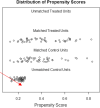Can inverse probability treatment weighting (IPTW) be used to assess differences of CRBSI rates between non-tunneled femoral and jugular CVCs in PICU patients?
- PMID: 35799133
- PMCID: PMC9264698
- DOI: 10.1186/s12879-022-07571-4
Can inverse probability treatment weighting (IPTW) be used to assess differences of CRBSI rates between non-tunneled femoral and jugular CVCs in PICU patients?
Abstract
Background: In children in the ICU, catheter-related bloodstream infections (CRBSI) have also been linked to mortality, morbidity, and healthcare costs. Although CRBSI poses many potential risks, including the need to avoid femoral access, there is debate regarding whether jugular access is preferable to femoral access in adults. Study reports support both perspectives. There is no consensus in meta-analyses. Children have yet to be examined in depth. Based on compliance with the central line bundle check lists, we aim to determine CRBSI risk in pediatric intensive care units for patients with non-tunneled femoral and internal jugular venous access.
Methods: A retrospective cohort study was conducted on patients with central venous catheters in the pediatric ICU of King Abdulaziz University Hospital between January 1st, 2017 and January 30th, 2018. For the post-match balance, we use a standardized mean difference of less than 0.1 after inverse probability treatment weighting for all baseline covariates, and then we draw causal conclusions. As a final step, the Rosenbaum sensitivity test was applied to see if any bias influenced the results.
Results: We recorded 145 central lines and 1463 central line days with 49 femoral accesses (33.79%) and 96 internal jugular accesses (66.21%). CRBSI per 1000 central line days are 4.10, along with standardized infections of 3.16. CRBSI risk differed between non-tunneled femoral vein access and internal jugular vein access by 0.074 (- 0.021, 0.167), P-value 0.06, and relative risk was 4.67 (0.87-25.05). Using our model, the actual probability was 4.14% (0.01-0.074) and the counterfactual probability was 2.79% (- 0.006, 0.062). An unobserved confounding factor was not identified in the sensitivity analysis.
Conclusions: So long as the central line bundle is maintained, a femoral line does not increase the risk of CRBSI. Causation can be determined through propensity score weighting, as this is a trustworthy method of estimating causality. There is no better way to gain further insight in this regard than through the use of randomized, double-blinded, multicenter studies.
Keywords: Catheter related blood stream infection (CRBSI); Causal inference; Central lines; Children; Inverse probability treatment weighting; Pediatric ICU; Propensity score.
© 2022. The Author(s).
Conflict of interest statement
Both authors declared no conflict of interest.
Figures




References
MeSH terms
LinkOut - more resources
Full Text Sources
Research Materials

